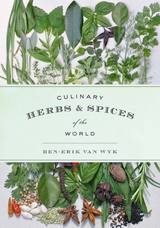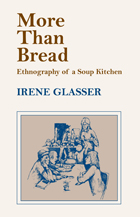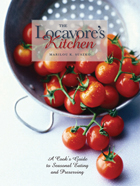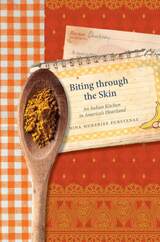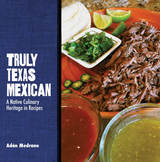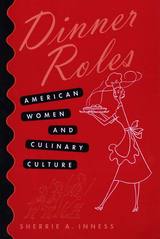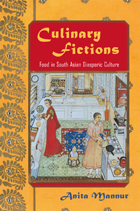CookingCollection by Cassandra Verhaegen (8 items)"A watched book never boils." Includes the following tags:
1962-, Agriculture & Food, Agriculture & Food Policy, American Women, Asian American & Pacific Islander, Childhood and youth, Cooking, American, Food, Food habits, Food habits in literature, Food in literature, Food supply, Gardening, Guidebooks, Indic, Kansas, Mexican, Poverty, Recipes, Regional & Cultural, Southwestern States, Specific Ingredients
See More
|
Culinary Herbs and Spices of the World
by Ben-Erik van Wyk
University of Chicago Press, 2014
For centuries herbs and spices have been an integral part of many of the world’s great cuisines. But spices have a history of doing much more than adding life to bland foods. They have been the inspiration for, among other things, trade, exploration, and poetry. Priests employed them in worship, incantations, and rituals, and shamans used them as charms to ward off evil spirits. Nations fought over access to and monopoly of certain spices, like cinnamon and nutmeg, when they were rare commodities. Not only were many men’s fortunes made in the pursuit of spices, spices at many periods throughout history literally served as currency.
In Culinary Herbs and Spices of the World, Ben-Erik van Wyk offers the first fully illustrated, scientific guide to nearly all commercial herbs and spices in existence. Van Wyk covers more than 150 species—from black pepper and blackcurrant to white mustard and white ginger—detailing the propagation, cultivation, and culinary uses of each. Introductory chapters capture the essence of culinary traditions, traditional herb and spice mixtures, preservation, presentation, and the chemistry of flavors, and individual entries include the chemical compounds and structures responsible for each spice or herb’s characteristic flavor. Many of the herbs and spices van Wyk covers are familiar fixtures in our own spice racks, but a few—especially those from Africa and China—will be introduced for the first time to American audiences. Van Wyk also offers a global view of the most famous use or signature dish for each herb or spice, satisfying the gourmand’s curiosity for more information about new dishes from little-known culinary traditions.
People all over the world are becoming more sophisticated and demanding about what they eat and how it is prepared. Culinary Herbs and Spices of the World will appeal to those inquisitive foodies in addition to gardeners and botanists.
1
|
Kitchen Literacy
by Ann Vileisis
Island Press, 2008
Ask children where food comes from, and they’ll probably answer: “the supermarket.” Ask most adults, and their replies may not be much different. Where our foods are raised and what happens to them between farm and supermarket shelf have become mysteries. How did we become so disconnected from the sources of our breads, beef, cheeses, cereal, apples, and countless other foods that nourish us every day?
Ann Vileisis’s answer is a sensory-rich journey through the history of making dinner. Kitchen Literacy takes us from an eighteenth-century garden to today’s sleek supermarket aisles, and eventually to farmer’s markets that are now enjoying a resurgence. Vileisis chronicles profound changes in how American cooks have considered their foods over two centuries and delivers a powerful statement: what we don’t know could hurt us. As the distance between farm and table grew, we went from knowing particular places and specific stories behind our foods’ origins to instead relying on advertisers’ claims. The woman who raised, plucked, and cooked her own chicken knew its entire life history while today most of us have no idea whether hormones were fed to our poultry. Industrialized eating is undeniably convenient, but it has also created health and environmental problems, including food-borne pathogens, toxic pesticides, and pollution from factory farms. Though the hidden costs of modern meals can be high, Vileisis shows that greater understanding can lead consumers to healthier and more sustainable choices. Revealing how knowledge of our food has been lost and how it might now be regained, Kitchen Literacy promises to make us think differently about what we eat.
2
|
More Than Bread
by Irene Glasser
University of Alabama Press, 2010
More Than Bread examines life in the dining room of the Tabernacle Soup Kitchen, located in Middle City in a New England state. What happens when one hundred guests, which include single mothers, drug addicts, alcoholics, the mentally ill, and the chronically unemployed, representing diverse age groups and ethnicities, come together in the dining room for several hours each day? Irene Glasser challenges the popular assumption that soup kitchens function primarily to provide food for the hungry by refocusing our attention on the social aspects of the dining room. The soup kitchen offers a model of a de-professionalized, nonclinical, nurturing setting that is in contrast to the traditional human services agency.
3
|
The Locavore’s Kitchen
by Marilou K. Suszko and Marilou K. Suszko
Ohio University Press, 2011
More and more Americans are becoming dedicated locavores, people who prefer to eat locally grown or produced foods and who enjoy the distinctive flavors only a local harvest can deliver. The Locavore’s Kitchen invites readers to savor homegrown foods that come from the garden, the farm stand down the road, or local farmers’ markets through cooking and preserving the freshest ingredients. In more than 150 recipes that highlight seasonal flavors, Marilou K. Suszko inspires cooks to keep local flavors in the kitchen year round. From asparagus in the spring to pumpkins in the fall, Suszko helps readers learn what to look for when buying seasonal homegrown or locally grown foods as well as how to store fresh foods, and which cooking methods bring out fresh flavors and colors. Suszko shares tips and techniques for extending seasonal flavors with detailed instructions on canning, freezing, and dehydrating and which methods work best for preserving texture and flavor. The Locavore’s Kitchen is an invaluable reference for discovering the delicious world of fresh, local, and seasonal foods.
4
|
Biting through the Skin
by Nina Mukerjee Furstenau
University of Iowa Press, 2013
At once a traveler’s tale, a memoir, and a mouthwatering cookbook, Biting through the Skin offers a first-generation immigrant’s perspective on growing up in America’s heartland. Author Nina Mukerjee Furstenau’s parents brought her from Bengal in northern India to the small town of Pittsburg, Kansas, in 1964, decades before you could find long-grain rice or plain yogurt in American grocery stores. Embracing American culture, the Mukerjee family ate hamburgers and softserve ice cream, took a visiting guru out on the lake in their motorboat, and joined the Shriners. Her parents transferred the cultural, spiritual, and family values they had brought with them to their children only behind the closed doors of their home, through the rituals of cooking, serving, and eating Bengali food and making a proper cup of tea.
As a girl and a young woman, Nina traveled to her ancestral India as well as to college and to Peace Corps service in Tunisia. Through her journeys and her marriage to an American man whose grandparents hailed from Germany and Sweden, she learned that her family was not alone in being a small pocket of culture sheltered from the larger world. Biting through the Skin shows how we maintain our differences as well as how we come together through what and how we cook and eat. In mourning the partial loss of her heritage, the author finds that, ultimately, heritage always finds other ways of coming to meet us. In effect, it can be reduced to a 4 x 6-inch recipe card, something that can fit into a shirt pocket. It’s on just such tiny details of life that belonging rests. In this book, the author shares her shirt-pocket recipes and a great deal more, inviting readers to join her on her journey toward herself and toward a vital sense of food as culture and the mortar of community.
5
|
Truly Texas Mexican
by Adán Medrano
Texas Tech University Press, 2014
Over thousands of years, Native Americans in what is now Texas passed down their ways of roasting, boiling, steaming, salting, drying, grinding, and blending. From one generation to another, these ancestors of Texas’s Mexican American community lent their culinary skills to combining native and foreign ingredients into the flavor profile of indigenous Texas Mexican cooking today.
Building on what he learned from his own family, Adán Medrano captures this distinctive flavor profile in 100 kitchen-tested recipes, each with step-by-step instructions. Equally as careful with history, he details how hundreds of indigenous tribes in Texas gathered and hunted food, planted gardens, and cooked. Offering new culinary perspective on well-known dishes such as enchiladas and tamales, Medrano explains the complexities of aromatic chiles and how to develop flavor through technique as much as ingredients. Sharing freely the secrets of lesser-known culinary delights, such as turcos, a sweet pork pastry served as dessert, and posole, giant white corn treated with calcium hydroxide, he illuminates the mouth-watering interconnectedness of culture and cuisine. The recipes and personal anecdotes shared in Truly Texas Mexican illuminate the role that cuisine plays in identity and community.
6
|
Dinner Roles
by Sherrie A. Inness
University of Iowa Press, 2001
Who cooks dinner in American homes? It's no surprise that “Mom” remains the overwhelming answer. Cooking and all it entails, from grocery shopping to chopping vegetables to clearing the table, is to this day primarily a woman's responsibility. How this relationship between women and food developed through the twentieth century and why it has endured are the questions Sherrie Inness seeks to answer in Dinner Roles: American Women and Culinary Culture. By exploring a wide range of popular media from the first half of the twentieth century, including cookbooks, women's magazines, and advertisements, Dinner Roles sheds light on the network of sources that helped perpetuate the notion that cooking is women's work. Cookbooks and advertisements provided valuable information about the ideals that American society upheld. A woman who could prepare the perfect Jell-O mold, whip up a cake with her new electric mixer, and still maintain a spotless kitchen and a sunny disposition was the envy of other housewives across the nation. Inness begins her exploration not with women but with men-those individuals often missing from the kitchen who were taught their own set of culinary values. She continues with the study of juvenile cookbooks, which provided children with their first cooking lessons. Chapters on the rise of electronic appliances, ethnic foods, and the 1950s housewife all add to our greater understanding of women's evolving roles in American culinary culture.
7
|
Culinary Fictions
by Anita Mannur
Temple University Press, 2009
For South Asians, food regularly plays a role in how issues of race, class, gender, ethnicity, and national identity are imagined as well as how notions of belonging are affirmed or resisted. Culinary Fictions provides food for thought as it considers the metaphors literature, film, and TV shows use to describe Indians abroad. When an immigrant mother in Jhumpa Lahiri’s The Namesake combines Rice Krispies, Planters peanuts, onions, salt, lemon juice, and green chili peppers to create a dish similar to one found on Calcutta sidewalks, it evokes not only the character’s Americanization, but also her nostalgia for India. Food, Anita Mannur writes, is a central part of the cultural imagination of diasporic populations, and Culinary Fictions maps how it figures in various expressive forms. Mannur examines the cultural production from the Anglo-American reaches of the South Asian diaspora. Using texts from novels—Chitra Divakaruni’s Mistress of Spices and Shani Mootoo’s Cereus Blooms at Night—and cookbooks such as Madhur Jaffrey’s Invitation to Indian Cooking and Padma Lakshmi’s Easy Exotic, she illustrates how national identities are consolidated in culinary terms.
8
|
| Click here to go to the beginning. | ||||||||
